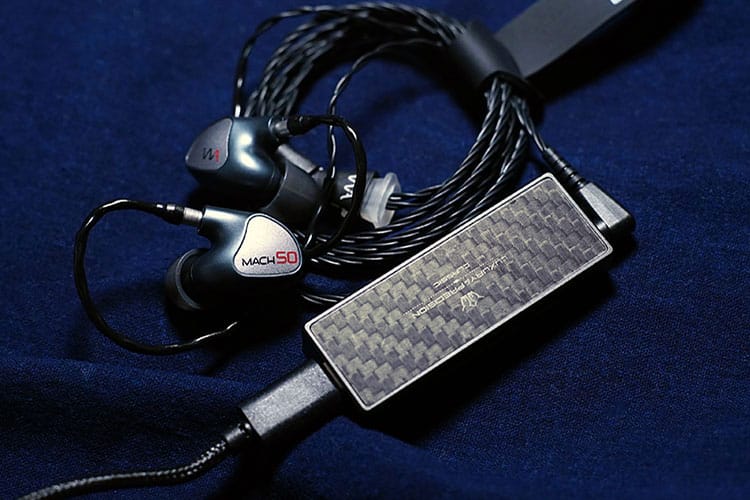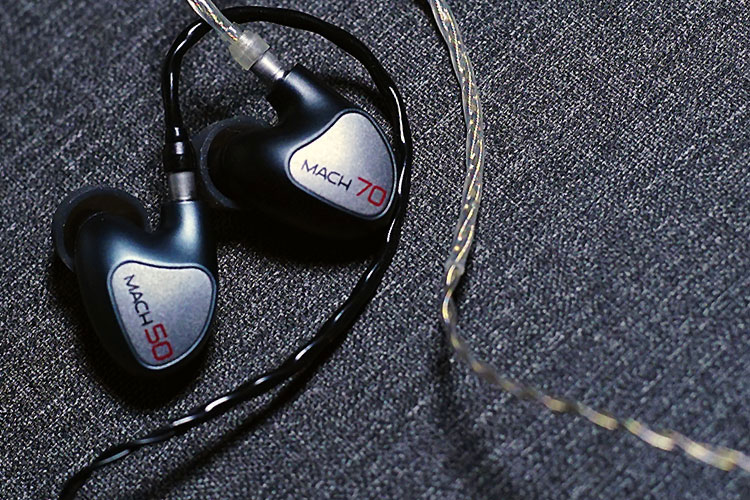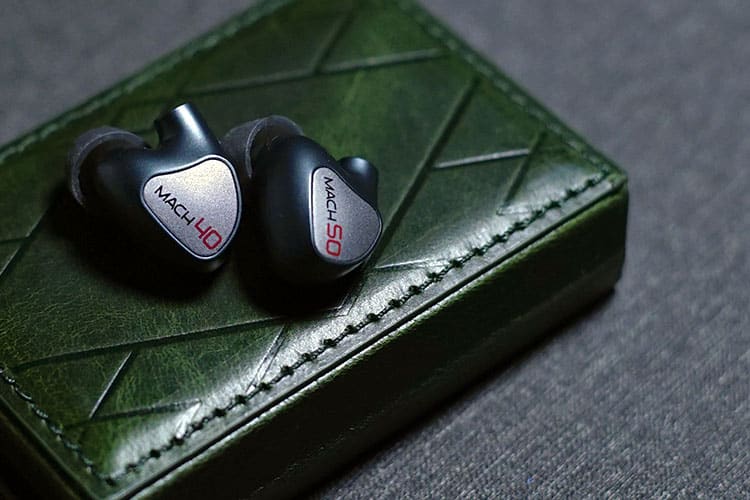In today’s review, we listen to the Westone Audio MACH 50 which is a new universal in-ear monitor designed with five balanced armature drivers. It is priced at £799.
Disclaimer: This is a sample sent in exchange for our honest opinion. Headfonics is an independent website that does not have any affiliate links. We thank both HiFi Headphones UK and Westone Audio for their support.
To learn more about Westone Audio IEMs we have previously covered on Headfonics you can click here.
Note, that this article follows our latest scoring guidance which you can read up on here.
The MACH 50 is the sub-flagship model for Westone Audio’s latest “Premium Bass” line with its model number depicting the 5 Balanced Armature drivers inside.
The extremely compact design looks almost identical to the MACH 70 and there are also some similarities in its crossover technology. 5 BA has always been a magical combination to me and looking at the price tag which is roughly half of MACH 70, there is a lot to anticipate.
Tech Highlights
The MACH 50 houses 5 balanced armature drivers in a proprietary 3-way configuration featuring a pair of tweeters, dual mids, and 1 single bass driver, consistent with all the “Premium Bass” line items that use only 1 BA for bass reproduction.
The design is rated 110dB in sensitivity and 32Ω in impedance, which makes it more responsive to power than the MACH 70 which is rated 100dB and 42Ω in impedance.
The rugged T2 connector system is used for interchangeable cables with the stock Linum SuperBax cable from Denmark measured at just 0.6Ω in impedance.
Design
Westone Audio has employed a very sleek and compact design for all its MACH series models. With the Sci-fi color scheme and metallic cover in front labeling the model number, the MACH 50 looks perfectly future-proof.
Westone Audio plays well with materials using polycarbonate for the housing to achieve an extreme light profile. Even when the faceplate is metallic, the satin finish gives it better resistance to scratches and wear.
Though the nozzle is not metallic it does feel sturdy. Together with the stealthy Linum cable that has excellent strength on all joints, this is one of the toughest and coolest stage monitors built.
Comfort & Isolation
Our experience with the MACH 80, 70, and 60 has proven that the aesthetics of the MACH series fit extremely well on the ears with its slightly tilted extrusion angle, which shall fit well on all ears without the need for adjustment all the time.
The slim design factoring in the almost weightless cable has contributed to enhanced comfort, especially when listening continuously for hours. Without compromising fidelity or pressing down the dynamic range due to the thin gauge, this combination is very well executed.
Tips
Every MACH series item comes with a lavish selection of tips that perfect the fitting experience. When inspected closely, the tips are slightly more protruded than common ear tips but this seems to help enhance passive noise isolation and bass delivery. It also spreads the weight of the IEM evenly on supporting areas.
You get 5 pairs of silicone flanges and 5 pairs of Westone Audio’s True-fit foams so users can easily find the exact right fit and reduce ambient noise to near silence. With foam tips, it is almost as quiet as custom monitors and shapes the bass slightly deeper and more elaboratively.
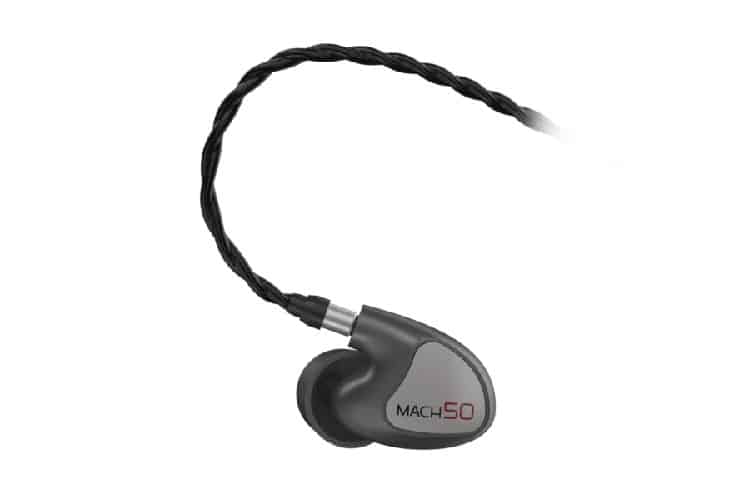
Stock Cable
The MACH 50 comes with Linum Estron SuperBaX as its stock cable and it has a low resistance rating measured at just 0.75Ω. As such, it will help reduce the coloration of the earphones. The cable is very soft so there is no need to worry about memory effects and it doesn’t get tangled easily.
We have been praising the slider on the Linum cable several times in other MACH series reviews, where the slider allows an instant, secure lock. That helps suppress microphonics and allows the earphones to stay secure, especially when you tie the cable behind the neck.
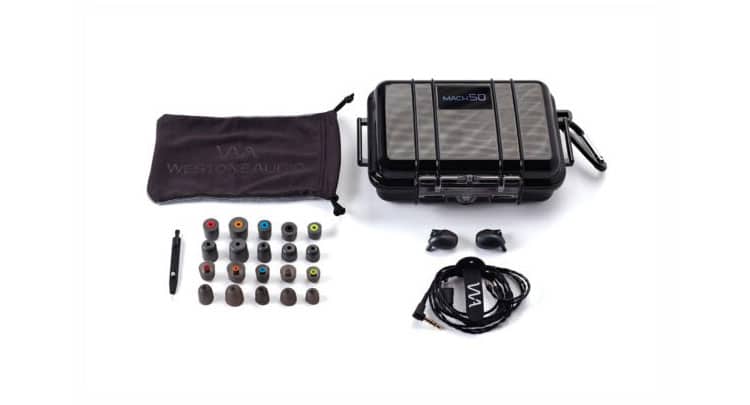
Packaging & Accessories
The packaging has a clean and futuristic design. Not only does it include 10 sets of foam tips, but there is also an Impact Resistant Pelican carrying case suitable for everyday carry. You also get a cleaner tool and a cable binder with an additional cloth bag for extra protection.
Sound Impressions
Looking at how similar the specifications are to the MACH 70, especially in the bass department, the MACH 50’s more affordable price tag seems too good to be true. The MACH 50 response is more linear, slightly tilted to the bass with a sweet and gentle roll-off in the treble.
However, it does not instantly wow me like the MACH 70’s more extended treble but the signature does slowly develop and sound immersive so, even after hours of listening, as it is not fatiguing at all.
The soothing vibes made up of punchy mid-lows and controlled treble helps to boost the dynamics of streaming content or with thinner outputs on Bluetooth receivers. When powered by weaker sources, the MACH 50 can still image quite well and sound rather lush and agile.
Bass
The MACH 50 is not shy of bass rumble. The quality instead of intensity is emphasized, and it sounds expansive and impactful on powerful sources like the Shanling M9.
With excellent sealing properties on Westone Audio’s tips, the bass is swiftly delivered and sounds deep, intense, and dense, also well under control.
On the MACH 50, there is sufficient energy in the 300-400Hz range so that darker voices and lower strings of acoustic instruments have good presence, It does not punch in your face but is swiftly articulated from the very low end, with just a gentle lift in the mid lows that allows deeper frequencies to be heard.
The bass tuning has some resemblance to the MACH 70 and 80, but the body and dynamics aren’t as strong as on the 70 which pushes the mid-lows forward, or the 80 which lifts the vocal overtones for higher definition.
I would describe the bass on the MACH 50 as accurate and resolving. One that can handle massive blows without flattening the output, while the speed on the MACH 50 allows it to maintain a moderately tight pace and to sound swift and energetic with different bass elements.
Mids
The midrange is very smoothly rendered on the MACH 50 and that is keeping the output clean albeit the bass punch with quite a bit of fullness and weight. Midrange instruments and vocal stands out more than the Premium Reference models as the bass energy empowers lower strings and dark voices to sound lusher and stronger in presence.
The detail retrieval power in the midrange is decent despite having strong mid-low intensity, and it impacts moderately fast to keep the output clean and controlled.
The transient response is great too with bass guitar strings, acoustic guitars, and flutes sounding intense and articulate. Accordions also work really well on the MACH 50 with its smoothness.
The higher mids are completely free of sibilance without killing the air, and the harmonics and openness are well preserved to complement the more weighted mid-lows.
The intimate, slightly warm tone with great depth in the mid-range as well as the rounded treatment makes it a great match for vocal works. If only it sounded slightly airier you might think you are listening to a dynamic driver.
Treble
The higher register on the MACH 50 is smoothly presented with sibilance around 6-7kHz dimmed. It is not a sharp roll-off that takes away the air and definition in the upper end, and you can still clearly hear the shimmer and shine of cymbals and hi-hats.
The top end of guitars and pianos are sounding rounded and polished. In this sense, it is not MACH 50’s forte to assist in mixing but the tuning is helping it to sound much more engaging and relaxing for light-hearted and relaxing music, especially with slow jazz and synthesized instruments.
Soundstage
The MACH 50 sounds fairly expansive and accurate in imaging. The vocal image or the position of strings being struck can be clearly defined in the soundstage rendered.
The deep and fast-paced low end is not exaggerated and helps stretch the width and depth in the perceived headroom. While the fullness in the mid-lows can fill up the space and bring instruments and voices up-front.
Darker voices are drawn quite near as if you are in the front few rows of a hall. Glass-shattering sharp voices are well controlled on the MACH 50 so they will not get hot or mess up the dynamics but it does limit the headroom a bit.
All elements are well-defined, and clearly positioned with good dynamic range maintained.
Synergy
Efficiency
At 32Ω impedance and 110dB SPL, the MACH 50 can be driven to sound quite dynamic on a dongle and sounds even more resolving and firm on DAPs with stronger voltage swings.
The background is dark on most devices and with higher gain, you may hear some hissing being picked up, but generally, it is quite dark with a decent dynamic range present.
I find the MACH 50 relatively easy to drive due to its fully balanced armature configuration and its sensitivity, also because of its weighted mid-lows. It can scale well with higher power and is able to coup with higher gain without getting hot.
Pairings
Powered by my MacBook Pro and my phones, the bass is cleanly defined and the mids elements are well separated. On the Luxury and Precision W2 dongle, both ends sound more defined and the midrange is outlined cleaner and sounds more elaborative and layered
If you want a smooth presentation the latest HiBy RS2 is a fun pairing that gives dense, creamy mids. Amping the MACH 50 or powering it with a more powerful DAP like the Shanling M7 will further stretch its dynamic range and transient performance, allowing the bass to be even more controlled and reach deeper.
I have been listening to the MACH 50 on the FiiO M11 Plus ESS and the Shanling M6 Pro which works pretty well too sounding firm, resolving, and dynamic as well as balanced in tone.
Select Comparisons
Westone Audio MACH 70
$1399
Technical
The MACH 70, the flagship model for the “Premium Bass” line, has two more drivers featuring a 1 bass, 2 mids, quad treble configuration. That means the difference between the MACH 70 and the MACH 50 is by 2 treble tweeters. The MACH 70 has the same 110dB sensitivity as the MACH 50, but it has a 42Ω rating that makes it slightly more power-demanding.
Design
It is hard to spot the visual difference except for the lighter grey color theme on the MACH 50 and the different cables supplied. The MACH 70 comes with the more premium ULTRABaX cable and the MACH 50 is packed with the stealthy SuperBaX Linum cable that looks more professional and is lighter in profile.
Performance
The MACH 50 is more sensitive to power and it is quite noticeable when you test it with a laptop or a dongle. That makes it ideal for pro-use putting it on a receiver or a mixing interface that may not output as much power as on a DAP or amplifier.
While the bass response feels similar possibly due to the same components being used, the MACH 70 exhibits a stronger V-shape signature and does not lean as much to the low mids.
It sounds brighter, and more defined, especially in the high-frequency response. Hi-hats attack snappier and vocal overtones are more clearly heard, at the same time the vocal feels more polished.
In contrast to the MACH 70, the MACH 50 is less dynamic without lifting mids-treble range frequencies for clarity, while there is a similar level of bass layering and an earlier roll-off in the higher register.
The more linear tuning also allows tweaks to be easily heard, for example when using the MSEB tuning function on the HIBY RS2 to boost clarity in the treble.
Westone Audio MACH 60
$1099
Technical
The MACH 60 has a dual low, dual mids, dual treble config and is paired with the same cable as seen on the MACH 50. The frequency response is stated as 8Hz to 20kHz, which is the same as the MACH 50, while the sensitivity on MACH 60 is 100dB @1kHz with a 35Ω impedance rating, which is quite a bit less responsive than the MACH 50.
In practice, the MACH 60 sounds more consistent on different devices and the MACH 50 does respond to more power and is more loyal to the tuning of the sources.
Design
The two IEMs look nearly identical with the same cable and the same color theme. The only way you can tell them apart is by the model number marked on the faceplates.
Performance
Testing both units on the Cayin RU6, it is noticeable the MACH 50 is more responsive to power to be easier driven to sounding more dynamic.
However, the MACH 60 has its treble more lifted in the 5kHz region and beyond, so the extra clarity and treble forwardness make it sound more neutral and open, also more resolving in the upper register.
On the FiiO M11 Plus ESS, the MACH 50 has a stronger tilt to the low end with the mid-lows being fuller. While it is not as energetic in the treble as the MACH 60, more attention is shifted to the low mids while the treble feels more rounded and sibilance-free.
When given a higher gain the MACH 50 can sound sharper in the upper vocal range, but it is not as airily extended and expansive as heard on the MACH 60.
Westone Audio MACH 40
$599
Technical
The most affordable item in our comparisons is the MACH 40 featuring a 4 BA driver with a dual low, 1 midrange, and 1 treble configuration. That setup is in contrast to the MACH 50 where the MACH 40 has a larger bass driver ratio on paper.
Similar to the MACH 60, the MACH 40 is less sensitive at 100dB @1kHz and 30Ω @1kHz in impedance. That is again quite a bit less sensitive than the MACH 50.
Design
The design is consistent throughout the MACH series and the MACH 40 and MACH 50 look pretty much the same, with the same cable being used.
Performance
On relatively lower output power the MACH 40 is as bassy as the MACH 50, and it sounds more confined in staging having the upper mids and sibilance zone further suppressed.
In other words, it is even more rounded than on the MACH 50 with the higher mids being boosted followed by a sharper roll-off. That empowers the vocal with more energy to cut through the mix and sound more defined. However, it is not as natural nor as effortless in the treble zone as heard on the MACH 50.
The MACH 40 exhibits a darker signature with different gears which allows it to pair better with sharper-sounding gears, or to use higher gain on various DAPs. It works better with pop and slow-paced tracks that are more elaborate on the lower end.
The MACH 50 can handle more genres of music at ease with its more even energy distribution and more natural response. It is more expansive headroom allows more instruments in the mix to be imaged distinctively.
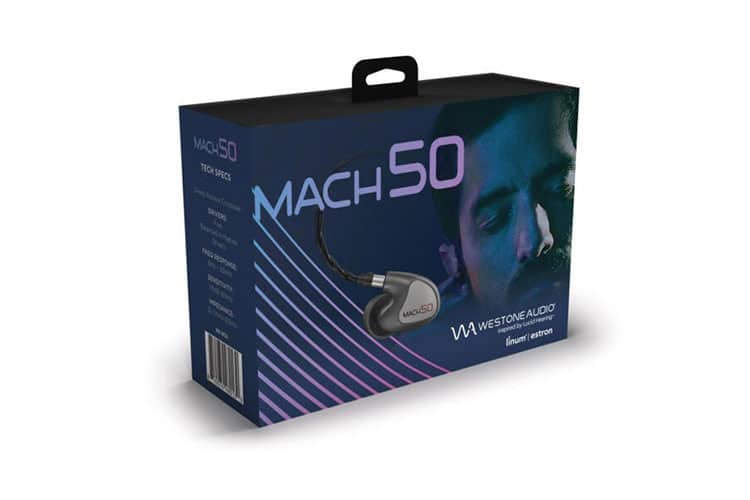
Our Verdict
The Westone Audio MACH 50 delivers a dense and vibrant vocal experience that also sounds very immersive with instruments across the midrange. This is a well-balanced, natural response over its 3-way, 5-BA configuration which I always think of it as a magical number for IEM design.
The sibilance-free, highly cohesive tuning is relaxing with various genres of music, at the same time the versatile, sensitive design allows the MACH 50 to sound dynamic with robust bass performance on a wide range of devices.
Westone Audio MACH 50 Specifications
- Connectivity: 3.5mm Single-ended
- Drivers: 5 x Balanced Armature
- Impedance: 32 ohms @ 1kHz.
- Frequency Response: 8Hz-20kHz
- Sensitivity: 110dB @ 1kHz
- Crossover 3-way Passive








